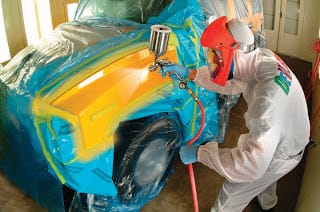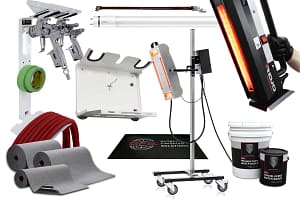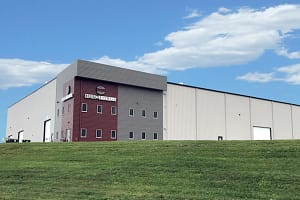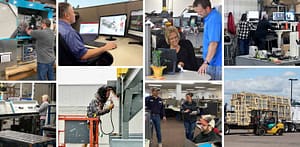What makes a paint booth filter cost effective?
The answer is “all of the above”. Seems simple enough, but if that’s all it takes, why doesn’t everyone have an effective system?
In reality, it’s seldom that easy to achieve “all of the above” with a single pass filtration system. Each application, each type of coating material, and each operator of a system create changes that affect the performance of filters. The right blend of science and deductive reasoning that encompass the application of a filter technology, in a source capture operation, can be a frustrating endeavor. It is best to evaluate the application parameters and determine a filtration product, or system, that best meets the requirements of “all of the above”?
The first step necessary to accomplish this task is to understand how the filter’s performance is affected by variations in the coating material and the process. Certain filtration products work better on certain coatings but must remain within the performance envelope of the original equipment with regard to resistance to air flow and efficiency.
Aftermarket paint booth filter suppliers, typically provide replacement products with the “me too” method. In effect, the equivalent products to those originally equipped with the spray booth, or currently in use, become the replacements. But, if that is correct; how does one determine if a replacement is truely equivalent?
The characteristics of the coating material that most affect filter life and performance, also dictate the type of delivery system that is required. Viscosity, solids content, and curing method will be varied, and the type of equipment required to apply the coating must be compatible with the coating material. This creates a multitude of variations that can affect the selection of a source capture, overspray removal system. But let’s not lose sight of the primary purpose of the role a filter plays, and that is to protect the fan and exhaust system from overspray build-up while this equipment performs the task of removing harmful vapors from the coating booth.

Curing methods also categorize coating materials in the way source capture occurs. Thermo-reactive, or UV-reactive coatings, and air-dry coatings will load differently. Thermo-reactive and UV-reactive coatings remain uncured and therefore demonstrate adhesive characteristics when sprayed. When pulled into a filter media, these types of coatings readily adhere to the fiber matrix and once captured, remain so until the combination of over-saturation and pressure causes the coating to pass through the media. Air-dry coatings may set up while entrained in the air stream or, after contact with the filter media. If “dry” when reaching the filter media, paint droplets may “bounce” off of the fibers and continue to migrate through the media until impinged or strained by the fiber matrix. Air-dry coatings that reach the filter media, and then dry, tend to load up on the “face” of the filter and will eventually “face-load” the media without any significant penetration through the fiber matrix.
In conjunction with curing method, the chemical composition of some air-dry coatings may pose a combustion hazard. Volatile organic compounds, or VOC’s, generally off-gas from liquid coatings in vapor form. When sufficient air flow does not dilute these emissions, heat energy can build up and create combustion of the coating material. Coatings that share this trait pose a consideration in the paint booth filter system operation, not only in the type of filtration to employ, but also how often a filter should be changed. Leaving saturated filters in the frames when the exhaust air flow is shut down may cause a fire hazard. Since a potential hazard exists from combustion, how it’s disposed of is also a concern.
In spray-to-waste powder coating systems, the powder is usually applied electro-statically. The powder-coat material that does not adhere and becomes an overspray will behave like an air dry coating. As such, powder-coat materials are subject to “particle bounce” as in the case of air dry coatings above, where the paint droplet literally can contact a filter fiber and bounce off, or around the fiber, until it is impinged in the paint arrestor. Typically, tackified filter media is utilized for this type of coating, and also for air-dry coatings that may cure while entrained in the air stream. Although powder coatings are typically a large diameter particle, the overspray can contain particles below 5 micrometers. If this type of system discharges back into the general plant atmosphere, HEPA (High-Efficiency Particulate Air) filters would be required as the final filter, and perhaps three stages of filters might be required to remove the overspray in a cost-effective manner.
Coating characteristics have an impact on paint booth filter performance, regardless of the operation. The coating material, however, represents only one part of the knowledge required to apply the most effective filter system. The performance efficiency of the filter must be determined for proper selection, especially when a multi-stage filtration system is in use.
The most commonly accepted performance evaluation for a paint arrestor is a paint “arrestance test”. In this test, the subject filter, or filter combination, is sprayed with a liquid coating material usually a high-solids, enamel. This coating can be any type supplied for the test, but when not specified, a 62%, high-solids has become the default coating. While this can be used to establish comparative performance for like products, attention must be given to variables that occur between the test coating and the coating material in actual use in a given application. Test coatings seldom simulate the coatings used in actual applications. Therefore, testing the actual coating material is the only accurate way of gauging the true performance of a paint arrestor.
The same can be said for using the efficiency from a test as the expected efficiency from that filter in an actual application. For instance, a filter tested on 62% high solids enamel will have a different efficiency when installed in an application using a coating material reduced to 30% solids. Penetration through the primary filter would be greater, arrestance efficiency would be lower and increased stack contamination and fugitive emissions could be the result.
Current regulations dictate that a filter should demonstrate an “Average Arrestance” efficiency of at least 98% using a 62% high solids coating as the test material. Local and regional environmental enforcement agencies typically accept the documented, independent, test reports as legitimate proof of the performance of a given collection media.
Efficiency is often misapplied as a measure of filter performance. Efficiency for paint arrestors is usually the “arrestance” efficiency, or the holding capacity of a filter. The recorded weight of all paint sprayed is accumulated as paint held by the paint booth filter, paint that may run off the filter on the ductwork and framing, and paint that penetrates the test filter and is held in the final filter. The weight of the coating material retained by the filter is determined simply by weighing the clean filter device, the final filter devices and subtracting that weight from the final loaded weights of the filters. This is the “paint holding capacity” of the test filter. The combined weight gain of those two filters is subtracted from the total weight sprayed to determine the runoff. Arrestance is the value obtained by dividing the weight gain of the test filter by the sum of the test filter and final filter weight gain. This percentage is referred to as “paint arrestance efficiency”.
Efficiency can also be a measure of the ability of a paint booth filter to remove paint droplets by average dimensional size. This is the “fractional efficiency” of a paint arrestor, and is of equal or even greater importance, depending upon the application and the type of coating material. According to information from the Research Triangle Institute, penetration size varies with the type of pre-filtration, the type of coating material in use, and the delivery equipment. In their study, the initial downstream particle size distribution values varied from 1.6 – 28 micrometers, in mean average diameter, after passing through various pre-filter mediums.
What does all of this information do to assist us determining the most cost-effective type of filtration for a coating operation? It means paint booth filter suppliers must have a command of performance differences between available filtration products, and the ability to apply these products correctly in a variety of coating applications. It also means that a greater level of awareness is required for the decision makers responsible for managing a coating operation.
At GFS we understand coating applications and the performance of the filtration used in all of our equipment. Our primary goal is to ensure that every GFS spray booth is designed to be compliant with existing regulations, utilize filtration that exceeds industry expectations for performance and is capable of providing cost-effective filtration that protects both the operators of our spray booths and the environment.
One of the best ways to highlight your business is through a story that you can share across your online platforms. It humanizes your business and shows that your business can make a meaningful impact. Your testimonial would be used as a project profile on the GFS Booth Blog and can be shared on your website and/or social media channels.
Complete this form and we’ll be in touch to showcase your company.

Shop a variety of GFS aftermarket products, including booth protection products and mobile accelerated curing units. And enjoy the convenience of fast and free ground shipping throughout the contiguous United States.

Located at GFS’ headquarters in Osseo, Wisconsin, the Center for Excellence is an innovative facility featuring an automotive refinish training center, as well as a separate space dedicated to technical product training.

GFS is continuously searching for talented, ambitious individuals to join our team. We aim to provide our employees with every opportunity to make an impact on the company and find their niche along the way — weather in a production, field services or an office position.